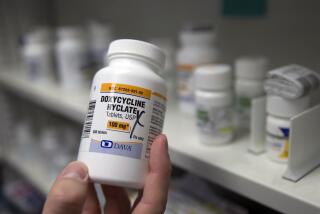Promising HIV prevention
- Share via
The recent announcement that a pill currently used to treat HIV infection can also help prevent it was an important milestone in the effort to keep people from getting the virus.
The breakthrough utilizes a strategy known as pre-exposure prophylaxis. At-risk people take a drug in advance of exposure to the pathogen that makes it less likely they will become infected.
The HIV drug’s success in a Phase III trial is one of several recent breakthroughs in HIV prevention. None of the approaches, which also include a vaginal gel and an AIDS vaccine, is perfect, but all are promising. Together they add momentum to the growing body of evidence that science, if properly focused and funded, can deliver effective methods of preventing HIV. And the advancements have appeared on the horizon at a time when the battle against AIDS is at a crossroads.
Until recently, there had been just one great advance in responding to HIV since it was discovered in 1983: a revolution in treatment. Thanks largely to AIDS activists who demanded expedited research and approvals, today there are more drugs licensed to treat HIV than there are for all other viruses combined. Generous donors and innovative pricing mechanisms have made these antiretroviral drugs available to about 36% of those in the developing world who need them to stay alive and healthy.
Increasingly, however, both donor and recipient governments are questioning the sustainability of foreign funding for antiretroviral treatment. Faced with the economic downturn, donor countries are resisting commitments that will continue to escalate indefinitely. Currently, about 7,100 people a day become infected. Two people are newly infected with HIV for every one who starts antiretroviral treatment. This year, donors to the Global Fund to Fight AIDS, Tuberculosis and Malaria committed $1 billion less than the minimum amount — $13 billion — needed for the fund to maintain current levels of treatment and add programs at a significantly reduced pace.
It has become clear that treatment for HIV, though still crucially important, can’t solve the problem. That will only happen through preventing transmission of the virus in the first place. The goal of the prevention revolution that is finally taking off is to end the devastation of AIDS once and for all. In order for governments to have the confidence to continue making the enormous investment required to provide access to treatment to all those living with HIV, they must have reasonable assurance that one day the bill will be paid in full. That will require having ways to reliably prevent new infections.
One way of reducing rates of HIV transmission is through campaigns that make people aware of all the currently available evidence-based methods of prevention. At the same time, we must expand and improve what is available. In the recent drug trial that demonstrated the effectiveness of pre-exposure prophylaxis, which was conducted among men who have sex with men in Peru, Ecuador, Brazil, South Africa, Thailand and the U.S., volunteers who took a daily dose of the antiretroviral treatment Truvada — a combination of two drugs — were 44% less likely to become HIV infected than those who took a placebo.
Experts will now debate whether a confirmatory trial is needed to license the combination drug for prophylactic use, but because it is already available, some physicians will probably prescribe it that way off label.
After a clinical trial in South Africa this summer found that an experimental vaginal gel containing the antiretroviral Tenofovir reduced the risk of HIV infection in female volunteers by 39%, the FDA has agreed to rapidly review further studies of the gel.
As for vaccines, the first proof of efficacy — albeit modest efficacy — in an HIV vaccine candidate was established in a large clinical trial in Thailand last year. Follow-up studies are being planned. And the discovery of multiple, potent antibodies that neutralize many strains of HIV has suggested new avenues for the design of AIDS vaccines.
According to some projections, adding microbicides and pre-exposure prophylaxis to the fully scaled-up implementation of available HIV prevention options could cut the global HIV infection rate in half. A broadly effective vaccine, on top of that, could eventually finish AIDS off.
Though the science for these new tools is promising, the funding base is flat, despite large investments of stimulus dollars by the United States government. The U.S. deserves praise for financing the lion’s share of both HIV treatment in Africa and HIV prevention research internationally. Other donor countries that are contributing to HIV treatment globally should also make simultaneous and significant investments in new prevention methods to ensure that their HIV costs won’t rise indefinitely. Governments of developing countries can also play their part, first by instituting proven HIV prevention efforts while being accountable for results as measured by reductions in new infections. Second, they can demand the development of new HIV prevention tools as passionately as they have demanded universal access to HIV treatment.
Seth Berkley is the CEO of the nonprofit International AIDS Vaccine Initiative.






